![]()
Return to Index/Main Page
| A lexicon of knife terminology: Section C | ||||||||||||||||||||||||||
| Numbers | A | B | C | D | E | F | G | H | I | J | K | L | M | N | O | P | Q | R | S | T | U | V | W | X | Y | Z |
C
C45 Steel: A carbon steel .45 Carbon, .4 Si, .65 Mn, .10 Mo, .40 Ni used in hand tools such as Hammers and Axes. Also known as 1045 tool steel.
California Clip: A slender clip blade that has a clipped spine that extends to over 2/3 the length of the blade said to resemble the state of California. Also known as a muskrat blade.
Camco: A line of economy made knives originally introduced by the Camillus Cutlery Company. Originally made in the USA, Camillus moved Camco production to China. A small number were produced shortly before bankruptcy. It is uncertain if Acme will produce knives under the Camco brand.
Camel or Camel Bone: Bone (normally leg) dervied from domesticated camels. It is considered a heavy, dense material. It is often found on knives made in Pakistan, however it is also imported into the United States and used by knife makers. In its natural state, camel bone tends to be darker than cattle bone but is otherwise similar.
Camillus: And old American Knife Company headquartered in New York that made high quality knives made by the U.S. Military as well as the Civilian market. They also provided blade material for most of the major American knife makers. In 2007 the company filed for bankruptcy as was bought by Acme Tools. After 2007 Acme began produicing Camillus knives in Taiwan and China. In 2012 Acme announced it would begin production of some product lines in the United States.
Camp Knife (Fixed Blade):
A generic term for a fixed blade knife designed for general outdoor use, most commonly a robust fixed blade knife knife, with a guard, approximately 9-10 inches long with a clip blade making up about half the length of the knife. The term if very nonspecific. (Compare to Bushcraft, Bowie, Bird & Trout, and Small Game Hunter)
Camp Knife (Folding): The name camp knife normally evokes the image of the cigar shapped 3 5/8 inch 4 blade knife with a spear master blade, can opener, caplifter/screw driver and awl blade.
This four blade Camp knife was adopted by the Boys Scouts of America in 1910 and was later issued in Great numbers by the U.S. Military making it a very common and popular type of camp knife. However, folding camp knives with various blade configutrations and tools also exist. In fact, the Camp knife was based on the Early Swiss Army Soldier's Knife Which is the precursor of Victorinox family of Swiss Army knives. Thus, it is always good to give additional information such as numbe rof blades or type of tools when describing a camp knife, or when possible call the knife by the manufacturers name. Also called a scout knife because of its association with the Boy Scouts. (See also Boy Scout Knife, Cub Scout Knife)
Canadian Belt Knife Specifically, a hunting knife designed by D. H. Russell designed knife currently manufactured by Grohmann of Nova Scotia Canada. As the pattern has been around for some time, several companies also make knives in the same pattern. This fixed blade knife features a slender leaf shaped blade approximately 4 inches long with a slightly offset handle and lacks a guard. The knife is used for skinning, gutting and caping animals. Also called a Belt Knife or Roach.

Canoe: A traditional pattern folding knife; a slip joint knife shaped like a Native American canoe with a large spear point blade at the top and secondary, smaller pen blade at the bottom. See Butterbean and Pen Knife for comparison.
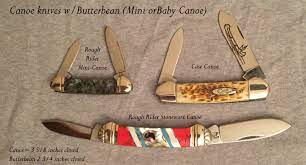
Canittler: A canoe pattern knife with three blades set up in whittler fashion, with the third blade normally being a coping blade.
Cap: The end of a knife. The pommel, the butt cap. In folding knives, it is the right end of a knife when looking at the obverse face of the knife.
Cap Lifter: A knife blade designed to open bottle. It is often combined with a flat head screwdriver or found near the tang end of scaling blades.
Cape Buffalo Horn: Handle material from the Cape Buffalo, domestic cattle from South Africa.
Caping: A fixed blade knife used for caping big game, that is for the removal of an animals hide for the purpose of trophy mounting.
Carbon: Present in all steels, it is the most important hardening element. Also increases the strength of the steel but, added in isolation, decreases toughness. Knife-grade that has more than .5% carbon (1/2 of one percent), is called "high-carbon" steel.
Carbon Steel: Steel with at least 0.4% carbon. Other trace elements do not need to be specified. Also known as W Steel or Plain Carbon Steel
Carraca: Another name for the Navaja de Muella. See listing for Navaja.
Case: see W.R. Case & Sons.
Cattleman: A name sometimes given to a Stockman knife that employs an Awk blade in place of the Spay blade loacted on the end of the knife Thus, the cattleman has three blades, the primary blade being a clip or spear and secondary being a sheepfoot both located on the top bolster. The third blade is a located at the butt is an awl or punch blade.
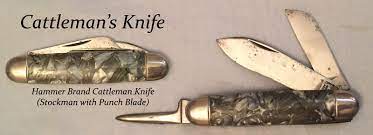
Ceramics: Blades made of ceramic materials. These are normally very brittle and cannot be sharpened by the user; however, they hold an edge well. This is most often used in kitchen cutlery.
Cigar: A knife that is shaped like a cigar; that is, the handle is slightly tapered from the middle toward both rounded ends. Both ends of the knife will normal have equal sized bolsters. The 4 blade camp knife is a cigar pattern knife..
Channel : The slot created by the knife’s liners in which a blade rests when the blades are folded. In most knives with blades attach on both ends (canoes,stockmans,etc) the blades rest in a communal central channel with cut-away liners, known as spacers. In most knives where the blades are attached at the top bolster (barlows, peanuts, trappers, etc) each blade has its own channel. Single blade knives (toothpicks sodbusters, etc) have one channel.
Channel Lock: See Liner Lock.
Chromium: Chromium is what makes stainless steel stain less. It is added to steel for wear resistance, hardening, and (most importantly) for corrosion resistance. Steel that has at least 11- 13% chromium added is typically deemed stainless. More chromium will increase stain resistance but make the steel weaker.
Cheetah: A traditional pattern folding knife; a knife style in which the cross bar is attached to the blade so that when the knife is folded the cross bar rests on top of the channel and when the blade is opened, the crossbar is held stationary at the top of the handle. A type of Stiletto. By having the cross bar move, the knife is less likely to get caught in the pocket. It called Cheetah because it cheats. When folded in looks an acts like a regular folding knife but when it is opened it becomes a s stiletto. (also called a Swing Guard)
Chef's Knife: Also known as a Cook's Knife The chef's knife is a traditonal fixed blade ktichen knife. In western culture there are two types of chef's knives: German and French. The German chef's knife have a more pronounced curve to the cutting edge while the French has a straighter cutting edge.
The chef's knife is'essentially a large drop point knife designed for cutting, chopping and slicing. It differs from the butcher knife in its blade geometry and purpose. The most common blade length for a chef's knife is 8 inches but larger knives are also popular. Smaller chef's knives are some times called a chef's utility knife. These have fallen from favor in recent years. See also Kitchen Knives, Butcher Knife.

Chef's Utility Knife: A smaller version of the Chef's Knife sometimes called a Mini-Chef's knife, the pattern was designed for chopping and mincing. The wide, short blade is similar to that of the palm skinner used by hunters.
The Chef's Utility Knife has fallen from favor as it is somewhat redundant. Most kitchen chores done by the utility knife can be done by the Chef's knife or other knives such as the paring or boning knife. For this reason, the Chef's Utility knife is not as common as it once was and is sometimes sought after by collectors. See also Chef's Knife, Kitchen knife.

China: Knives made in China are made in The Peoples Republic of China or Mainland China.
Choil: The unsharpened section of the blade. If a guard is present, the choil will be in front of the guard on the blade itself. On most folding knives it is the unsharpened part of the blade where you find the tang stamp.
Classic: 1) An often ill-defined and therefore meaningless term used to sell knives; especially online. see vintage. 2) Any pattern of knife that has been around for a long period of time, such as Trapper or Sodbuster; not an exotic or unusual pattern. The more appropriate term is Traditional.
Classic SD: The most produced model of Victorinox Swiss Army Knives; today, the blades consists of a small pen blade, combination nail file-screwdriver and scissors. It also has a key ring plus detachable tweezers and toothpick stored in the handle. The Wenger equivalent is known as the Esquire or Classique. They are often used for promotional or advertising means and come in various scale colors and material types including precious stones.
Clasp Knife: A traditional pattern folding knife; originally the term applied to any traditional pattern, large folding knife with one or more blades. (Large meaning 5 or more inches in the closed position) Today, it is debatable if a clasp knife has a locking blade or not.
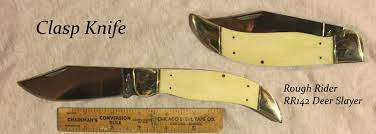
Clasp Lock: The more appropriate term for a single bladed clasp knife with a locking blade.
Clip: A blade type in which the lower cutting edge curves upward in a slow graceful arch about 1/3 from the tip of the blade and the top unsharpened edge is clipped in a concave pattern near the last ¼ of the blade in way to form a point when it reaches the lower edge. This is one of the most common knife points used and considered very versatile. (Compare to drop point.)
Cocobolo: A popular wood that comes from the Cocobolo tree used for knife handles. Its bright colorful wood ranges in color from deep purple or red to bright orange. It is easy to work with and can be highly polished.
Cocktail Knife: A specialty knife related to the bartender knife that was popular in the 1950s. It was used in the preperation of mixed drinks and other cutting chores at cocktail parties. See also: Host Knife
Coke Bottle: A knife handle shape which is similar to that of Coca-cola bottle. It is usually a large frame, often over 4 1/2 inches but can be smaller. In folding knives it normally has bolsters on both ends. A popular pattern for hunters, trappers, and jack knives.
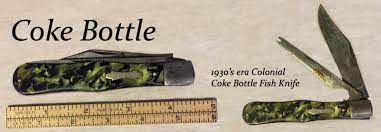
Cold Steel: A mid-range knife company with manufacturing in Japan, Taiwan and China.
Collectible: 1) An often ill-defined and therefore meaningless term used to sell knives; especially online. see vintage 2) Typically a collectible is something made for the purpose of collecting. This has no bearing on the actual quality or quantity of the item. Often reproductions or commemorative items are considered collectible. They rarely go up in value. Compare to Collectors Item
Collector’s Item: 1) An often ill-defined and therefore meaningless term used to sell knives; especially online. see vintage 2) Normally, an older, out of production item, that was not designed as collectable with a known appraised value and a demand that out strips current product availability. Compare to collectibles.
Colonel Coon: Originally Colonel Coon knives were custom made by Adrian A. Harris at Tennessee Knife Works; a company he founded in 1978 in his home town of Columbia, Tennessee. The company’s name is derived from Harris’ nickname at the Columbia Military Academy. Among other innovations and quality built knives, Harris developed a chemical way to etch his knife blades, a process that is still used today by many knife makers. He later sold his company and the etching process to W.R. Case & Sons in 1988. Today, the brand is owned by Smokey Mountain Knife works with the knives being produced by Queen Cutlery according to SMKW specifications. They are released in small collectors’ runs and are considered high-end knives. (The earlier Colonel Coon knives were assembled in Harris’ own factory with the blade blanks be provided by Queen.)
Colonial: An old American company that went from making mid range to economy made knives manufactured in the Providence Rhode Island (USA). While some of their knives are still made in the USA, most are currently manufactured overseas to their specifications.
Colt: An American trademark more famous for its firearms than cutlery. SMKW currently markets the Colt Trademarked knives. Most Colt knives are made in China, with a few being manufactured States-side.
Combo blade : A blade on Victorinox and Wenger Swiss Army knives that serves the purpose of both a can opener and cap lifter while also have a screwdriver tip!
Combination blade (combo): Any knife blade that has more than one type of tool represented. For instance: combination screwdriver-bottle opener or combination scaler-hook remover-cap lifter. Combination blades are most common on many camping/utility knives.
Combination Edge: Blades that have a partially serrated and partially plain edge on the same cutting surface. This is a popular design on tac knives.
Combs’ Custom: Hen & Rooster knives customized and by Stacy Combs and normally sold through Frost Cutlery Company. They are numbered and should come wih a certificate of authenticity.
Congress: A traditional pattern folding knife; normally a four blade knife with a slightly concave handle. Each end of the knife normally has two blades, with the main blades being equal length sheepfoot blades and the secondary blades traditionally being a pen and a coping blade. The Pattern most likely originated in England but found favor in the Southern United States where it was popular on Tobacco and Cotton plantations where the large Sheepfoot blade proved useful. It is popular knife among whittlers. The name refers to the way the way the blades come together or congress.
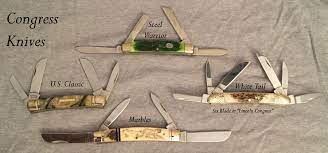
Congress Whittler: A knife combining the traditional handle style of a Congress knife with the three blade pattern of a whittler. Normally the main blade will be a sheepfoot with a coping and pen blade located on the opposite end of the congress fame.
Coping: A knife blade in which the blade’s top and bottom edge runs parallel until near the very tip. The tip of the blade is clipped in a straight fashion at a sharp angle (45-60°) leaving the cutting edge slightly longer than the top edge. The front clip portion is not sharpened. (Compare to sheepfoot and tanto) Coping blades are often secondary blades on Whittlers on other knife patterns.
Copperhead: A handle style with a top end similar to that of a canoe, a slightly serpentine handle and bottom rounded bolster. It is normally trapper style with a clip and skinner blade both attached to the top bolster with each blade resting in its own channel.
Corelon: An acrylic resin used in the production of knife handles and scales. Corelon was developed by and is is a registered trademark of Frost Cutlery. Frost uses the material on Hen & Rooster as well as other brand names they currently own. Aside from the brands they own, Frost also uses Corelon scales for Knives made by W. R. Case & Sons and sold exclusively through Cutlery Corner Network. Frost injects the acrylic resin with a wide variety of colors in order to simulate Coralline Rock from by the algae of the same name. Corelon was first used in December, 2001 Trademark was applied for July, 2004 and granted July 2006.
Corncob: A jig pattern cut into bone so that resembles an eaten cob of corn.
Cotton Sampler: A large frame horticulture knife with a large coping or a specially modified sheepfoot blade used for grafting. See pruning and rope knife for comparison. (The term normall refers to folding knives but there are fixed blade cotton samplers as well.

Cripple Creek: A high end house brand of SMKW, featuring traditional pattern folding knives made in the USA.
CRKT - Columbia River Knife & Tool: An American company that manufactures knives in the US as well as globally.
Cro-Van :1095 Steel with added Chromium (1%) and Vanadium (.18%) to improve hardening and strength. The term usually refers to knives made by Ka-Bar. It is sometimes refered to as semi-stainless carbons steel due to the added Chromium.
Cross Guard: A protective extension that separates the knife handle for blade. See Quillon.
Cub Scout Knife: The Cub Scout knife normally refers to the Official Three Blade Cub Scout Camp or Utility Knife. The camp knife features bolsters and either bone or jigged delrin scales, often in dark blue. The Utility is a bolsterless version with blue smooth celluloid scales The three blade are a Spear master blade plus a caplifter/screw driver and a punch. Both the punch and screw driver have liner locks that keep them in place when opened. The main blade does not lock. While the official 4 blade Boy Scout knife is 3 5/8 inches, the Cub Scout knife is just 3 3/8 inches closed. The Cubs Scout were officially organized in 1930. It was soon after this, the Cub Scout knife was introduced as the official Cub Scout Knife.
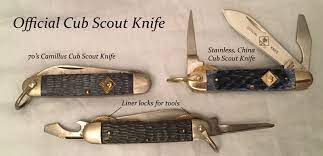
Curly Wood: Same as burl wood but normally specified by type of tree -- curly maple, curly oak, etc.)
Custom Knife. 1) Typically a factory produced knife released in a small numbered series that has been altered in some way by a knife customizer. This is normally involves using special materials, hand engraving or scrimshaw work. The should more correctly be called Customized Factory Knives. 2) Knives that are entirely built by hand by an individual, often requiring hand forging of blades and other parts, not relying on any factory parts. These are true custom knives with no two being exactly alike.
Cuticle Blade: A short curved blade used for finger nail care designed to remove hang nails and clean under finger nails. A cuticle tip is sometimes added to file blades.
CV Steel:1095 Steel with added Chromium (1%) and Vanadium (.18%) to improve hardening and strength. The term usually refers to knives made by W.R. Case & Son but others also use the steel. It is sometimes refered to as semi-stainless carbons steel due to the added Chromium.
Return to Index/Main Page